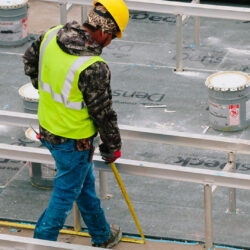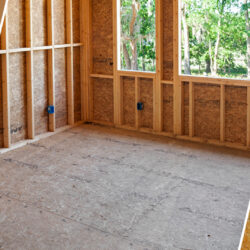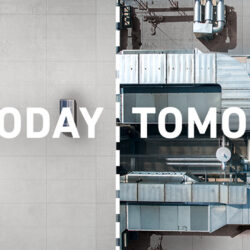Remember virtual reality in the 1990s? Users wore oversized headsets and gloves to experience and manipulate a heavily pixelated, virtual environment. At the time, no one was really sure how to use virtual reality for anything other than video games and personal entertainment.
Immersive technologies have come quite a long way since then. Thought leaders see limitless potential in virtual, and now augmented reality, for professional applications, including construction. The virtual imagery is more sophisticated, and the hardware less cumbersome.
The VR and AR software market is growing by leaps and bounds, with market revenue expected to reach $55.01 billion by 2021.[1] One industry that stands to benefit significantly from immersive technology is construction. Tech-forward companies in this sector are investing in the technology to supplement 3-D design and modeling tools. According to one projection, the distribution of the augmented and mixed reality market will grow to 14% in engineering and 7% in real estate by 2022.[2]
Virtual and augmented reality allow contractors and building owners to see what a building should look like before construction, and compare that image to what the building looks like in real time. And that could be a game changer for the industry.
Augmented vs. virtual
To understand how immersive technologies like augmented reality and virtual reality could transform the construction industry, it’s important to distinguish between the two. Whereas virtual reality will place you inside a virtual, three-dimensional building, augmented reality will project a holographic, full-scale image of the building onto an empty jobsite.
Virtual reality creates an immersive experience; a headset that displays 360-degree images and creates stereo sound makes it appear and sound like you are in a virtual world.
Augmented reality, on the other hand, enhances what you see. If you’ve ever played Pokemon Go, where the app places a Pokemon on top of what your camera is looking at, you’ve experienced augmented reality. Furniture retailers like IKEA have also incorporate augmented reality into their apps so you can see how a piece of furniture might look in a room by aiming your camera toward the space where you’d want to place the furniture.
It’s a similar idea with AR in construction. Project team members can use AR when determining where to place or orient a building. You can see augmented reality through a headset or smart glasses, but it’s more easily available through a tablet or smartphone app.

Construction benefits
As the paper blueprint moves closer to becoming a dinosaur, the construction industry is entering the next generation of 3-D modeling — through augmented reality and virtual reality technologies.
More constructors and architects are using building information modeling, or BIM, to create three-dimensional models of their projects; pairing virtual reality with BIM would make it possible to “walk” inside and experience these models. And augmented reality would allow builders to overlay 3-D BIM information onto a project site.
Although much of the industry has yet to adopt these technologies, AR and VR offer a host of benefits:
1. Precision in planning and design: Virtual environments provide architects, designers and clients with a realistic and more precise model of a project while it is still in the design phase.
2. Avoidance of costly mistakes: By viewing a building virtually, project team members can correct problems and miscalculations in real time so mistakes don’t happen onsite – saving both time and money on the project. Builders can also create more efficiencies virtually before the actual construction takes place.
3. Better collaboration: Virtual reality makes it possible for project team members, including the client, to collaborate in a shared environment, and from any location in the world.
4. Improved training: Virtual and augmented reality can allow trainees to practice a trade in a simulated environment, and without the real-world risks. The technologies also lower the costs and hazards of training. This is particularly useful given that construction often involves expensive equipment and jobsite hazards.
Overall, VR and AR technology can help builders produce a better quality product, a safer jobsite, shorter timelines, reduced labor costs and a faster response when issues arise.
[1] https://www.prnewswire.com/news-releases/future-of-global-digital-reality-market-forecast-to-2021—vr-application-in-the-manufacturing-sector-is-projected-to-increase-by-98-9-between-2017-and-2021–300716802.html
[2] https://designbuildexpo.com.au/building-construction/augmented-reality-building-the-future-of-the-industry/
This article is intended solely as general information. Ultimately, the design and detailing of any project, assembly or system is the responsibility of a professional, and all projects must comply with applicable building codes and standards. For information concerning the limited warranty for the DensElement® Barrier System, visit www.denselement.com. GP Gypsum disclaims any responsibility or liability for the architecture, design, engineering or workmanship of any project, assembly or system.









